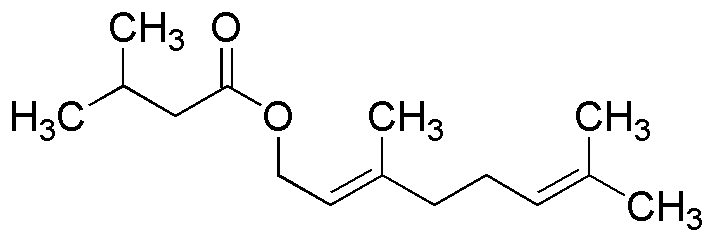Geranyl isovalerate is widely utilized in research focused on:
- Fragrance Industry: This compound is often used in perfumes and scented products due to its pleasant floral aroma, enhancing the sensory experience in personal care items.
- Flavoring Agents: It serves as a flavoring agent in food products, providing a fruity and citrusy taste that can improve the appeal of various consumables.
- Pharmaceuticals: In medicinal chemistry, it is explored for its potential therapeutic properties, contributing to the development of new drugs with enhanced efficacy.
- Aromatherapy: Geranyl isovalerate is used in essential oils for aromatherapy, promoting relaxation and well-being, which is beneficial in wellness and spa industries.
- Cosmetic Formulations: The compound is incorporated into cosmetic products for its skin-conditioning properties, making it valuable in skincare formulations.
General Information
Properties
Safety and Regulations
Applications
Geranyl isovalerate is widely utilized in research focused on:
- Fragrance Industry: This compound is often used in perfumes and scented products due to its pleasant floral aroma, enhancing the sensory experience in personal care items.
- Flavoring Agents: It serves as a flavoring agent in food products, providing a fruity and citrusy taste that can improve the appeal of various consumables.
- Pharmaceuticals: In medicinal chemistry, it is explored for its potential therapeutic properties, contributing to the development of new drugs with enhanced efficacy.
- Aromatherapy: Geranyl isovalerate is used in essential oils for aromatherapy, promoting relaxation and well-being, which is beneficial in wellness and spa industries.
- Cosmetic Formulations: The compound is incorporated into cosmetic products for its skin-conditioning properties, making it valuable in skincare formulations.
Documents
Safety Data Sheets (SDS)
The SDS provides comprehensive safety information on handling, storage, and disposal of the product.
Product Specification (PS)
The PS provides a comprehensive breakdown of the product’s properties, including chemical composition, physical state, purity, and storage requirements. It also details acceptable quality ranges and the product's intended applications.
Certificates of Analysis (COA)
Search for Certificates of Analysis (COA) by entering the products Lot Number. Lot and Batch Numbers can be found on a product’s label following the words ‘Lot’ or ‘Batch’.
*Catalog Number
*Lot Number
Certificates Of Origin (COO)
This COO confirms the country where the product was manufactured, and also details the materials and components used in it and whether it is derived from natural, synthetic, or other specific sources. This certificate may be required for customs, trade, and regulatory compliance.
*Catalog Number
*Lot Number
Safety Data Sheets (SDS)
The SDS provides comprehensive safety information on handling, storage, and disposal of the product.
DownloadProduct Specification (PS)
The PS provides a comprehensive breakdown of the product’s properties, including chemical composition, physical state, purity, and storage requirements. It also details acceptable quality ranges and the product's intended applications.
DownloadCertificates of Analysis (COA)
Search for Certificates of Analysis (COA) by entering the products Lot Number. Lot and Batch Numbers can be found on a product’s label following the words ‘Lot’ or ‘Batch’.
*Catalog Number
*Lot Number
Certificates Of Origin (COO)
This COO confirms the country where the product was manufactured, and also details the materials and components used in it and whether it is derived from natural, synthetic, or other specific sources. This certificate may be required for customs, trade, and regulatory compliance.

